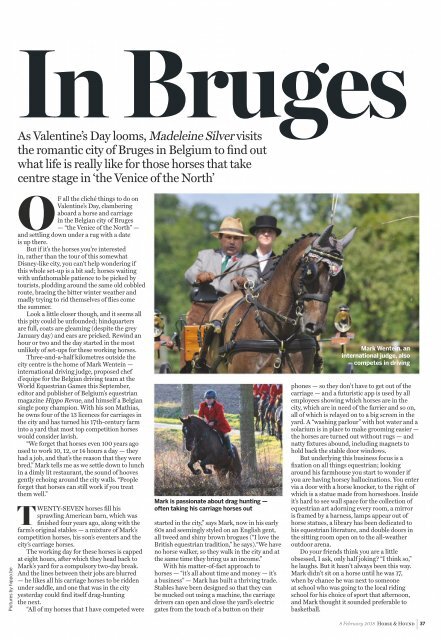Horse_amp_amp_Hound__06_February_2018
Create successful ePaper yourself
Turn your PDF publications into a flip-book with our unique Google optimized e-Paper software.
In Bruges<br />
As Valentine’s Day looms, Madeleine Silver visits<br />
the romantic city of Bruges in Belgium to find out<br />
what life is really like for those horses that take<br />
centre stage in ‘the Venice of the North’<br />
Pictures by hippo.be<br />
OF all the cliché things to do on<br />
Valentine’s Day, clambering<br />
aboard a horse and carriage<br />
in the Belgian city of Bruges<br />
— “the Venice of the North” —<br />
and settling down under a rug with a date<br />
is up there.<br />
But if it’s the horses you’re interested<br />
in, rather than the tour of this somewhat<br />
Disney-like city, you can’t help wondering if<br />
this whole set-up is a bit sad; horses waiting<br />
with unfathomable patience to be picked by<br />
tourists, plodding around the same old cobbled<br />
route, bracing the bitter winter weather and<br />
madly trying to rid themselves of flies come<br />
the summer.<br />
Look a little closer though, and it seems all<br />
this pity could be unfounded; hindquarters<br />
are full, coats are gleaming (despite the grey<br />
January day) and ears are pricked. Rewind an<br />
hour or two and the day started in the most<br />
unlikely of set-ups for these working horses.<br />
Three-and-a-half kilometres outside the<br />
city centre is the home of Mark Wentein —<br />
international driving judge, proposed chef<br />
d’equipe for the Belgian driving team at the<br />
World Equestrian Games this September,<br />
editor and publisher of Belgium’s equestrian<br />
magazine Hippo Revue, and himself a Belgian<br />
single pony ch<strong>amp</strong>ion. With his son Mathias,<br />
he owns four of the 13 licences for carriages in<br />
the city and has turned his 17th-century farm<br />
into a yard that most top competition horses<br />
would consider lavish.<br />
“We forget that horses even 100 years ago<br />
used to work 10, 12, or 14 hours a day — they<br />
had a job, and that’s the reason that they were<br />
bred,” Mark tells me as we settle down to lunch<br />
in a dimly lit restaurant, the sound of hooves<br />
gently echoing around the city walls. “People<br />
forget that horses can still work if you treat<br />
them well.”<br />
TWENTY-SEVEN horses fill his<br />
sprawling American barn, which was<br />
finished four years ago, along with the<br />
farm’s original stables — a mixture of Mark’s<br />
competition horses, his son’s eventers and the<br />
city’s carriage horses.<br />
The working day for these horses is capped<br />
at eight hours, after which they head back to<br />
Mark’s yard for a compulsory two-day break.<br />
And the lines between their jobs are blurred<br />
— he likes all his carriage horses to be ridden<br />
under saddle, and one that was in the city<br />
yesterday could find itself drag-hunting<br />
the next.<br />
“All of my horses that I have competed were<br />
Mark is passionate about drag hunting —<br />
often taking his carriage horses out<br />
started in the city,” says Mark, now in his early<br />
60s and seemingly styled on an English gent,<br />
all tweed and shiny brown brogues (“I love the<br />
British equestrian tradition,” he says).“We have<br />
no horse walker, so they walk in the city and at<br />
the same time they bring us an income.”<br />
With his matter-of-fact approach to<br />
horses — “it’s all about time and money — it’s<br />
a business” — Mark has built a thriving trade.<br />
Stables have been designed so that they can<br />
be mucked out using a machine, the carriage<br />
drivers can open and close the yard’s electric<br />
gates from the touch of a button on their<br />
Mark Wentein, an<br />
international judge, also<br />
competes in driving<br />
phones — so they don’t have to get out of the<br />
carriage — and a futuristic app is used by all<br />
employees showing which horses are in the<br />
city, which are in need of the farrier and so on,<br />
all of which is relayed on to a big screen in the<br />
yard. A “washing parlour” with hot water and a<br />
solarium is in place to make grooming easier —<br />
the horses are turned out without rugs — and<br />
natty fixtures abound, including magnets to<br />
hold back the stable door windows.<br />
But underlying this business focus is a<br />
fixation on all things equestrian; looking<br />
around his farmhouse you start to wonder if<br />
you are having horsey hallucinations. You enter<br />
via a door with a horse knocker, to the right of<br />
which is a statue made from horseshoes. Inside<br />
it’s hard to see wall space for the collection of<br />
equestrian art adorning every room, a mirror<br />
is framed by a harness, l<strong>amp</strong>s appear out of<br />
horse statues, a library has been dedicated to<br />
his equestrian literature, and double doors in<br />
the sitting room open on to the all-weather<br />
outdoor arena.<br />
Do your friends think you are a little<br />
obsessed, I ask, only half joking? “I think so,”<br />
he laughs. But it hasn’t always been this way.<br />
Mark didn’t sit on a horse until he was 17,<br />
when by chance he was next to someone<br />
at school who was going to the local riding<br />
school for his choice of sport that afternoon,<br />
and Mark thought it sounded preferable to<br />
basketball.<br />
8 <strong>February</strong> <strong>2018</strong> <strong>Horse</strong> & <strong>Hound</strong> 37


